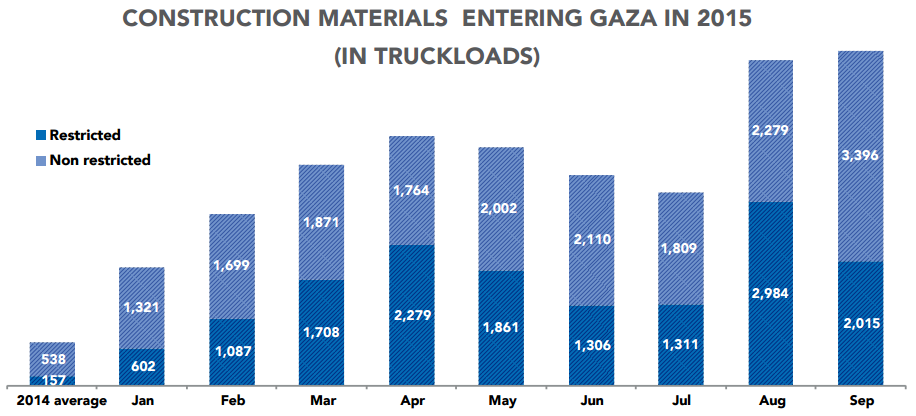Reconstruction of over one quarter of totally-destroyed homes ongoing or about to start
Israel removes restrictions on the import of aggregates
As of early October, reconstruction of 1,134 homes totally destroyed during the 2014 hostilities, constituting less than ten per cent of the total caseload for this category (12,584) was reportedly underway. The reconstruction of the first totally destroyed home funded by UNRWA was completed in October.[1] Funding for an additional 2,250 units, or a further 16 per cent of the caseload is reportedly confirmed, although the timing for the actual financial transfers and the start of work on the ground remains unclear.[2]
Despite the generous pledges made by many countries during the 2014 Cairo Conference for the reconstruction of Gaza, a funding gap still exists for the reconstruction of over three-quarters (9,200 units) of the totally destroyed homes.[3]
Progress in repairing damaged homes has been more significant, including the completion of nearly 12 per cent of severely damaged homes, allowing an estimated 5,000 displaced people to return home.

In the meantime, approximately 95,000 people whose homes were destroyed or severely damaged are currently accommodated with host families, in rented apartments, prefabricated units, tents and makeshift shelters, or in the rubble of their previous homes. Their living conditions raise a range of protection concerns, including overcrowding, limited access to basic services, lack of privacy, tensions with host communities, risks due to unexploded ordnance and exposure to weather extremes.
Since May 2015, the Gaza Reconstruction Mechanism (GRM) has continued to facilitate the entry of restricted building materials (mainly cement, aggregates and metal bars) for the reconstruction of totally destroyed homes through its “residential stream”. Imports of these materials were barred following the imposition of the blockade in 2007 and have been restricted since 2010 following classification by the Israeli authorities as “dual-use” (civilian and military) items.
The launch of the residential stream has led to an increase in the volume of these and non-restricted building materials entering Gaza (see chart). In September, a total of 5,411 truckloads of construction materials entered Gaza, an increase of 55 per cent compared with the monthly average since the beginning of 2015 and eight times the monthly average during 2014.

In October, the Israeli authorities removed aggregates (i.e. gravel) from the “dual-use” list of goods. This is the third time this year that the list has been modified, with previous changes including both additions and removals.[4] Consequently, individuals and organizations will now be able to import aggregates without prior approval from the Israeli authorities through the GRM or other mechanisms. However, the Israeli authorities will retain a quota of 400 truckloads of aggregate per day, despite the recent expansion of the Kerem Shalom crossing that has significantly increased the potential volume of goods that can be processed.
By mid-October restricted materials allocated by the GRM for approved participants in the residential stream totaled nearly 1.7 million tons. However, less than 20 per cent of this amount has so far been procured by beneficiaries from the authorized vendors.[5] The large gap between the GRM allocations and the actual purchase by beneficiaries from authorized vendors can be attributed, among other reasons, to the modality of distribution of financial assistance in installments based on progress. This can also be attributed to the availability of locally produced aggregates (from crushed rubble) and metal bars, which are significantly cheaper than the materials imported via Israel, although the poor quality of these materials poses a risk to the safety of structures built with them.
Despite recent progress, a more rapid pace of reconstruction will demand timely disbursement of donations pledged by the international community at the Cairo Conference one year ago; additional capacity for the entry of construction materials, including reopening crossings other than Kerem Shalom; and the removal of additional critical construction materials and equipment from the dual use list, particularly wood.
* This section is based on a contribution by the Shelter Cluster.









